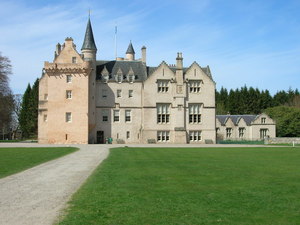As my grandfather read the last page of Robert Louis Stevenson’s Dr. Jekyll and Mr. Hyde, “Will Hyde die upon the scaffold? or will he find courage to release himself at the last moment?,” he looked at me. “And that, The Strange Tale of Dr. Jekyll and Mr. Hyde, is the story of your ancestor, Deacon Brodie,” he said.
I loved hearing tales of our family, the Brodies’, history from my grandfather and looking at pictures of Brodie Castle in Scotland. But this, surely, was only a tall tale. After all, it was fiction, and I am real. Robert Louis Stevenson’s characters, Dr. Jekyll and Mr. Hyde, certainly could not be my ancestor, could they?
For years, I assumed my grandfather was teasing me with the story of Dr. Jekyll and Mr. Hyde. That was, until I saw a special on The History Channel. I was watching television on a family vacation, when Lost Worlds: Jekyll and Hyde aired. I was Dr. Jekyll and Mr. Hyde’s descendant.
Deacon Brodie: Dr. Jekyll and Mr. Hyde?
Apparently, my grandfather was correct. Deacon William Brodie really was Robert Louis Stevenson’s inspiration for Dr. Jekyll and Mr. Hyde. By day, he was an upright citizen. At night, he was a terror to Edinburgh. According to The History Channel, Dr. Jekyll’s and Mr. Hyde’s split personality encapsulates Deacon Brodie’s dual life.
Deacon Brodie lived in Edinburgh, Scotland from 1741-1788 as a respected member of society. He was a cabinet maker, member of the Town Council and Deacon (Head) of the Incorporation of Wrights and Masons. However, his occupation also led to his moral demise.
Part of Deacon Brodie’s responsibilities included working as a locksmith. While repairing locks, he would often make himself an extra copy, without informing others. These unauthorized keys were then used by himself the three criminals he led: Ainslie, Smith and Brown. They would return with Deacon Brodie’s keys at later dates and rob people’s homes.
Deacon Brodie and Robert Louis Stevenson
Deacon Brodie lived in Edinburgh during a terrifying period in the city’s history. Vandalisms, robberies and murders were commonplace in the city. How much of this can be directly attributed to Deacon Brodie is uncertain. However, there is strong evidence for Deacon Brodie’s influence on Robert Louis Stevenson’s Strange Tale of Dr. Jekyll and Mr. Hyde.
Deacon Brodie was eventually caught and hung. Through his trial, his secretive life became clear to everyone in Edinburgh. Yet, Robert Louis Stevenson would have known Deacon Brodie on a more intimate level.
Although Dr. Jekyll and Mr. Hyde was not published until 1886, a century after Deacon Brodie was hung in 1788, Robert Louis Stevenson knew of Deacon Brodie. Deacon Brodie had done work for Robert Louis Stevenson’s father, and Robert Louis Stevenson’s family owned furniture made by Deacon Brodie. Robert Louis Stevenson may have never met Deacon Brodie, but he undoubtedly grew up hearing stories of the double-life man.
Deacon Brodie’s Death
Deacon Brodie was hung on October 1, 1788. Standing atop the gibbet, which he had designed, in Edinburgh on that day, he attempted to evade fate. Deacon Brodie had bribed the executioner to ignore a steel collar he hoped would prevent the rope from killing him. The details of the device are vague, but the tale of what would happen afterwards is even less certain.
According to official records, Deacon Brodie died on October 1, 1788 and was buried at Parish Church in Buccleuch. However, his grave is unmarked. There is evidence that Deacon Brodie was not buried, but survived his hanging. His body was quickly removed from the gibbet by the executioner. According to The History Channel, he may have found cover at a friend’s house and then fled for the South Pacific.
Deacon Brodie Lives On
Regardless of where and when Deacon Brodie died, his story lives on. One day, I will tell my grandchildren of how their ancestor was Dr. Jekyll and Mr. Hyde. Will they believe me, or will they think I am just teasing them? Hopefully, they will not know if I am telling the truth or not.
Deacon Brodie’s dual life is not meant to be told by facts. It was a mystery and always will be. The best way to capture Deacon Brodie’s life is with a story, like Robert Louis Stevenson’s Dr. Jekyll and Mr. Hyde or my grandfather’s tales.
Sources:
Deacon William Brodie
Deacon Brodie’s Life
The History Channel: Lost Worlds: Jekyll and Hyde
More From Scott:
Worrying About My Wife in a Tornado
Jeremy Lin, Christian Athlete
Bubba Watson, Christian Golfer
Bes SU Basketball Recruits
Best SU Football Recruits
